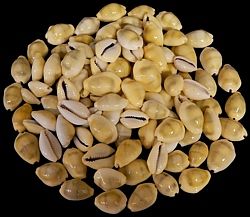One Money Cowry Shell measuring up to 1 inch. *****
One Money Cowry Shell, measuring up to 1 inch.
Orders usually process within 2 to 5 business days.
Email us at ja1@mindspring.com Make Your Selections and Shipping Preference. We Will Email You the amount of the Shipping Cost. When you receive the shipping cost go back into Shells of Aquarius and click into Purchase Shipping Label. There you will find UPS or USPS. Click into the option you decided on and make your payment. Your order will ship when shipping payment is received.
Monetaria moneta, common name the Money Cowrie
The Money Cowrie, is a species of the small sea snail, a marine gastropod mollusk in the family Cypraeidae, the cowries
This species is called "money cowrie" because the shells were historically widely used in many Pacific and Indian Ocean countries as shell money before coinage was in common usage.(REF: WoRMS : Monetaria moneta)
It is a quite small cowry, up to 3 cm (1.2 in), irregular and flattened, with very calloused edges and roughly subhexagonal. The color is pale (from white to dirty beige), but the dorsum seems transparent, often greenish grey with yellowish margins, with sometimes darker transverse stripes and a delicate yellow ring. The opening is wide and white, with pronounced denticules. The mantle of the live animal is mottled with black and off-white.
The Monetaria moneta shells varies widely in shape and color; resulting in the species having numerous taxonomic synonyms.
The Money Cowry is found across the Indo-Pacific tropical waters. They are present in numerous regions, including East and South Africa, Madagascar, the Red Sea and the Persian Gulf, Maldives, eastern Polynesia, Galapagos, Clipperton and Cocos islands off Central America, southern Japan, Midway and Hawaii, and northern New South Wales and Lord Howe Island (REF: Poutiers, J. M. (1998). Gastropods).
Money Cowries live in intertidal rocky areas and shallow tide pools among sea weed, coral remains, and empty bivalve shells. It can be found on and under rocks in shallow water and on exposed reefs at low tide. It feeds on algae and marine vegetation growing on loose rocks and pieces of dead coral (REF: Poutiers, J. M. (1998). Gastropods).
Money cowries were commonly used as a medium of exchange in many areas of Africa, Asia and the Pacific islands until the late 19th century (REF: Poutiers, J. M. (1998) Gastropods).
The Maldives provided the main source of cowrie shells, throughout Asia and parts of the East African coast. Huge amounts of Maldivian cowries were introduced into Africa by slave traders.
Money Cowries were also traded to Native Americans by European settlers (REF: Hogendorn, Jan and Johnson Marion: The Shell Money of the Slave Trade. African Studies Series 49, Cambridge University Press, Cambridge, 1986).
Scientific classification
Domain: Eukaryota
Kingdom: Animalia
Phylum: Mollusca
Class: Gastropoda
Subclass: Caenogastropoda
Order: Littorinimorpha
Family: Cypraeidae
Genus: Monetaria
Species: M. moneta
Binomial name: Monetaria Moneta
(Linnaeus, 1758)
